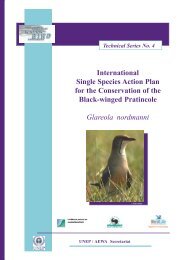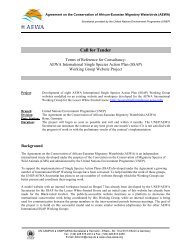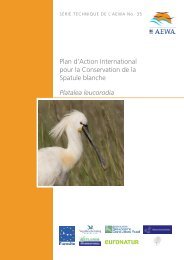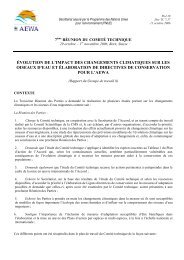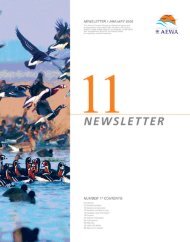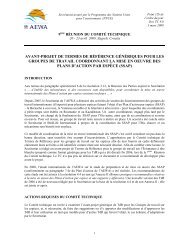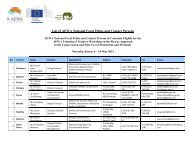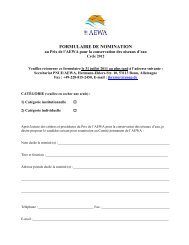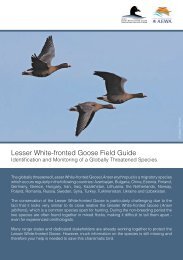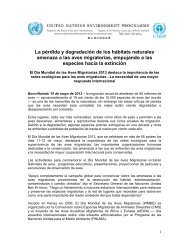International Single Species Action Plan for the ... - AEWA
International Single Species Action Plan for the ... - AEWA
International Single Species Action Plan for the ... - AEWA
Create successful ePaper yourself
Turn your PDF publications into a flip-book with our unique Google optimized e-Paper software.
<strong>AEWA</strong> Technical Series No. 36<br />
dossier was transmitted by BirdLife <strong>International</strong> to <strong>the</strong> CMS Secretariat in July 2005. Some<br />
stakeholders felt that <strong>the</strong> dossier was incomplete and/or did not accurately represent <strong>the</strong> actual<br />
situation. In such cases, <strong>the</strong> stakeholders concerned were encouraged to provide <strong>the</strong> Scientific<br />
Council with additional in<strong>for</strong>mation. Thirteen such contributions were taken into account by<br />
<strong>the</strong> Scientific Council in preparing its conclusions and recommendations, finalised in<br />
November 2005 at <strong>the</strong> 13th Meeting of <strong>the</strong> CMS Scientific Council, Nairobi, Kenya, 18<br />
November 2005 (attached as Annex 9a; additional independent comments by Dr Robert C.<br />
Lacy appended as Annex 9b).<br />
The following are <strong>the</strong> Scientific Council’s conclusions (numbered <strong>for</strong> clarity, but o<strong>the</strong>rwise<br />
quoted verbatim):<br />
1. “It is desirable to have a wide genetic diversity among wild Lesser Whitefronts.<br />
2. There appears to be no undisputed answer at present to <strong>the</strong> question of whe<strong>the</strong>r <strong>the</strong><br />
Fennoscandian population (as represented by <strong>the</strong> birds breeding in Norway) is<br />
genetically distinct from <strong>the</strong> nearest breeding birds to <strong>the</strong> east, in nor<strong>the</strong>rn Russia.<br />
Given <strong>the</strong> uncertainty, we take <strong>the</strong> cautious approach that <strong>the</strong>re might be a potentially<br />
valuable genetic distinction, and that we should not deliberately interfere with it (<strong>for</strong><br />
instance, by boosting <strong>the</strong> Fennoscandian population with wild birds from elsewhere),<br />
unless or until such interference may become inevitable.<br />
3. Given <strong>the</strong> small size of <strong>the</strong> wild Fennoscandian population, if possible, a captive<br />
breeding population of birds from this source should be established and maintained as<br />
a priority. We recognise that <strong>the</strong>re are risks involved in taking eggs and/or young<br />
birds from <strong>the</strong> wild population, but that careful use of a known surplus (that is, those<br />
birds that would have died or been killed in <strong>the</strong>ir first winter) may be a practical<br />
conservation option.<br />
4. We consider that every ef<strong>for</strong>t should be made to conserve <strong>the</strong> Fennoscandian birds<br />
down <strong>the</strong>ir traditional migration routes into sou<strong>the</strong>astern Europe and <strong>the</strong><br />
Caspian/Central Asian region. We recognise that this is a major challenge. We<br />
endorse <strong>the</strong> current LIFE project that aims to safeguard <strong>the</strong> birds and <strong>the</strong>ir habitats<br />
along <strong>the</strong> western route. It is our opinion that all appropriate ef<strong>for</strong>ts should also be<br />
made to conserve <strong>the</strong> wild populations of <strong>the</strong> species in its o<strong>the</strong>r flyways.<br />
5. We consider that doubts do remain about <strong>the</strong> genetic make-up of <strong>the</strong> existing freeflying<br />
birds, originally introduced into <strong>the</strong> wild in Fennoscandia, and which winter in<br />
<strong>the</strong> Ne<strong>the</strong>rlands. It does seem to us that not all, but a large part, of <strong>the</strong> scientific<br />
community will never be completely satisfied concerning <strong>the</strong> level of genetic<br />
contamination from <strong>the</strong> Greater White-fronted Goose Anser albifrons and o<strong>the</strong>r<br />
species, which many will regard as impossible to eliminate. Despite genuine ef<strong>for</strong>ts to<br />
improve <strong>the</strong> genetic purity of existing captive flocks we consider that <strong>the</strong>se flocks are<br />
not to be regarded as potential sources <strong>for</strong> release to <strong>the</strong> wild.<br />
6. Given <strong>the</strong> possibility that <strong>the</strong> above-mentioned free-flying birds, or <strong>the</strong>ir descendants,<br />
may pose a risk to <strong>the</strong> genetic make-up of <strong>the</strong> wild Fennoscandian population, <strong>the</strong><br />
Scientific Council is of <strong>the</strong> opinion that <strong>the</strong>se birds should be caught or o<strong>the</strong>rwise<br />
removed from <strong>the</strong> wild. We do not say this lightly, nor underestimate <strong>the</strong> practical<br />
and o<strong>the</strong>r difficulties involved. We recommend that a feasibility study be undertaken<br />
as a matter of urgency.<br />
7. We believe that <strong>the</strong>re is nothing against establishing a group in captivity of purebred<br />
Lesser Whitefronts from <strong>the</strong> wild, western Russian stock, and it may well prove<br />
valuable to have such a group in <strong>the</strong> future. However, we do not believe that it is<br />
appropriate to release such birds to <strong>the</strong> wild now or in <strong>the</strong> immediate future.<br />
8. For <strong>the</strong> present, we do not support <strong>the</strong> introduction of Lesser Whitefronts into<br />
flyways where <strong>the</strong>y do not occur naturally. We have borne in mind <strong>the</strong> powerful<br />
argument concerning <strong>the</strong> improved safety of birds in <strong>the</strong>se flyways, as well as<br />
practical considerations, such as current proposals that could quickly be put into<br />
effect. However, we consider that modifying <strong>the</strong> natural behaviour of Lesser<br />
Whitefronts in this respect, as well as unknown ecological effects in <strong>the</strong> chosen new<br />
<strong>International</strong> <strong>Single</strong> <strong>Species</strong> <strong>Action</strong> <strong>Plan</strong> <strong>for</strong> <strong>the</strong> Conservation of <strong>the</strong> Lesser White-fronted Goose 35



